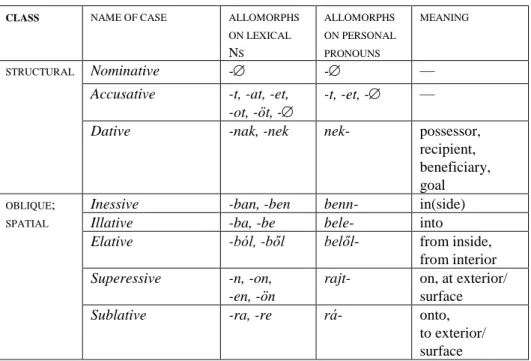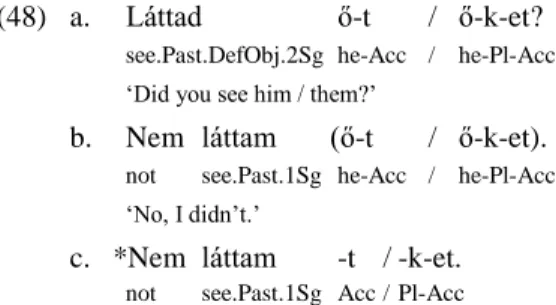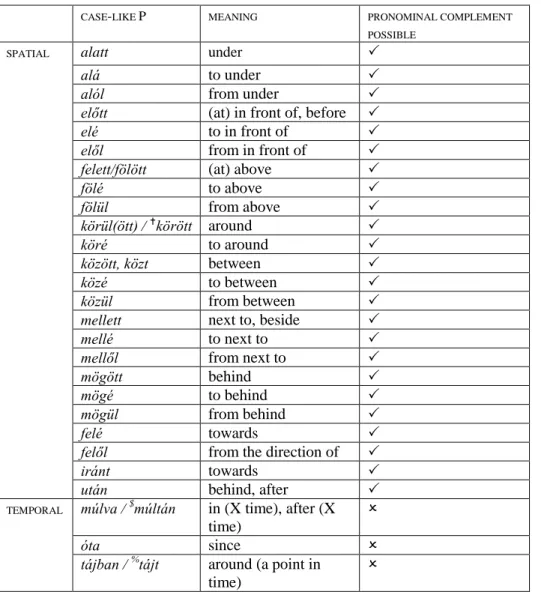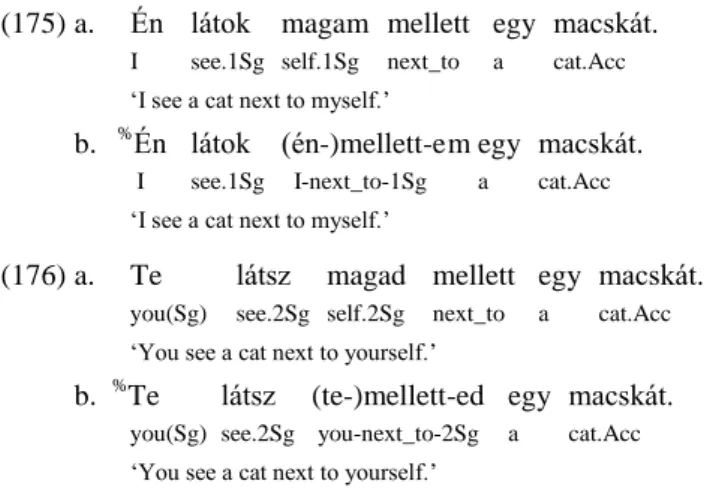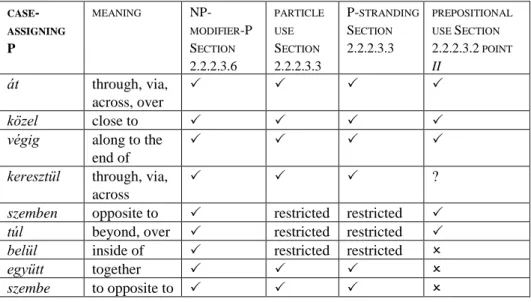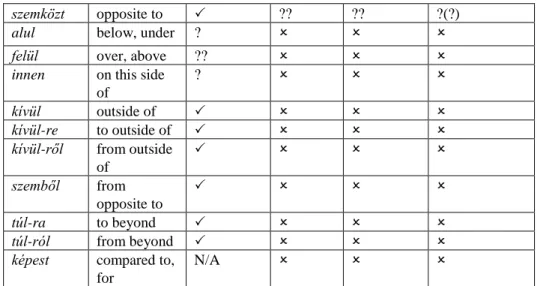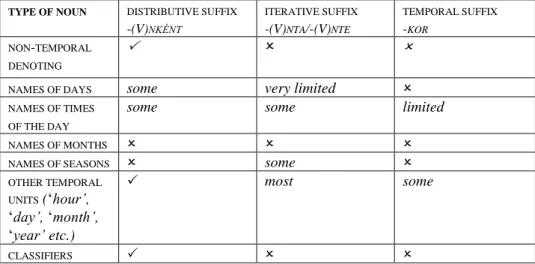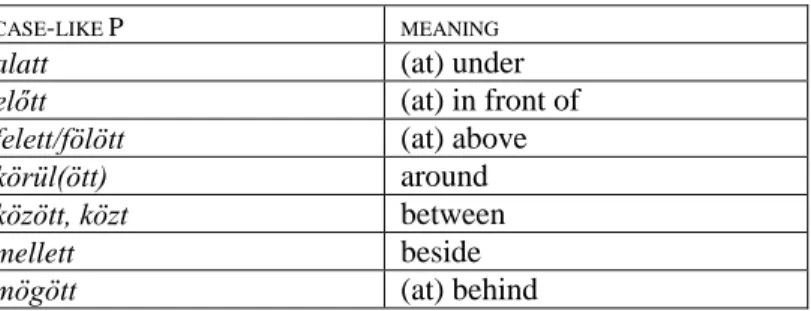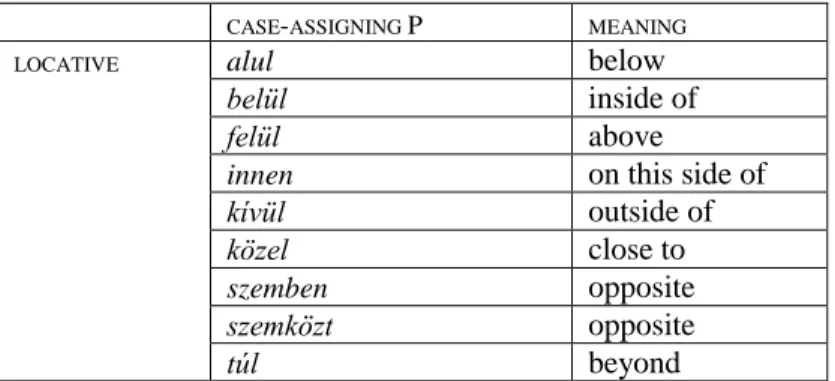Chapter 2
Postpositions: formal and semantic classification
Éva Dékány and Veronika Hegedűs
2.1. Introduction 14
2.2. Formal characterization 14
2.2.1. Case suffixes 14
2.2.1.1. The inventory and form of case suffixes 14
2.2.1.2. Complementation 32
2.2.1.3. Separability of the suffix and its complement in the clause 42 2.2.1.4. Combination with the Delative and Sublative case 43
2.2.1.5. N + case suffix modifying a noun 44
2.2.1.6. Modification 45
2.2.1.7. Conjunction reduction 45
2.2.1.8. Double case-marking 46
2.2.2. Postpositions 49
2.2.2.1. Introduction: Two classes of postpositions 49
2.2.2.2. Case-like postpositions 50
2.2.2.2.1. The inventory and form of case-like Ps 50
2.2.2.2.2. Complementation 60
2.2.2.2.3. Separability of the P and its complement in the clause 64 2.2.2.2.4. Combination with the Delative and Sublative case 65 2.2.2.2.5. N + case-like posposition modifying a noun 66
2.2.2.2.6. Modification 67
2.2.2.2.7. Conjunction reduction 68
2.2.2.2.8. PP-internal coding of reflexivity 68
2.2.2.3. Case-assigning postpositions 69
2.2.2.3.1. The inventory and form of case-assigning postpositions 69
2.2.2.3.2. Complementation 72
2.2.2.3.3. Separability of the P and its complement in the clause 76 2.2.2.3.4. Combination with the Delative and Sublative case 77 2.2.2.3.5. N + case-assigning postposition modifying a noun 78
2.2.2.3.6. Modification 78
2.2.2.3.7. Conjunction reduction 79
2.2.2.3.8. Case-assigning Ps: summary of the variation 80 2.2.2.4. Taking stock: the relation between case suffixes and postpositions 81
2.2.3. Verbal particles 82
2.2.3.1. The inventory of verbal particles 82
2.2.3.2. Verbal particles are (parts of) PPs 83
2.2.3.3. Separability from the verb 85
2.2.3.4. The formal properties of verbal particles 90
2.2.4. Adverbs 95
2.2.4.1. Adverbs derived by suffixation 96
2.2.4.1.1. Adverbs derived by productive suffixes 96
2.2.4.1.2. Adverbs formed by semi-productive and miscellaneous suffixes 100 2.2.4.2. Adverbs which are homophonous with adjectives 119
2.2.4.3. Other adverbs 121
2.3. Semantic classification 121
2.3.1. Spatial Ps 121
2.3.1.1. Basic semantic distinctions 121
2.3.1.2. Locative Ps 125
2.3.1.2.1. Locative case suffixes 125
2.3.1.2.2. Locative case-like postpositions 126
2.3.1.2.3. Locative case-assigning postpositions 127
2.3.1.2.4. Locative particles 128
2.3.1.2.5. Locative adverbs 129
2.3.1.3. Directional Ps 131
2.3.1.3.1. Directional case suffixes 131
2.3.1.3.2. Directional case-like postpositions 134
2.3.1.3.3. Directional case-assigning postpositions 136
2.3.1.3.4. Directional particles 137
2.3.1.3.5. Directional adverbs 140
2.3.2. Temporal Ps 140
2.3.2.1. Temporal postpositions 140
2.3.2.2. Temporal adverbs 144
2.3.2.3. Temporal uses of locative Ps 145
2.3.3. Other: non-spatiotemporal Ps 150
2.3.3.1. Non-spatiotemporal case suffixes 150
2.3.3.2. Non-spatiotemporal case-like postpositions 151
2.3.3.3. Non-spatiotemporal case-assigning postpositions 152
2.3.3.4. Non-spatiotemporal particles 153
2.3.3.5. Non-spatiotemporal adverbs 154
2.4. Where to draw the line: Borderline cases of postpositions 154
2.4.1. Participial postpositions 154
2.4.1.1. The inventory and form of participial postpositions 154
2.4.1.2. Complementation 157
2.4.1.3. Separability of the P and its complement in the clause 160 2.4.1.4. Combination with the Delative and Sublative case 161
2.4.1.5. N + participial Ps modifying a noun 161
2.4.1.6. Modification 162
2.4.1.7. Conjunction reduction 164
2.4.1.8. Combination with a verbal particle 165
2.4.1.9. Taking stock: participial Ps between participles and Ps 165
2.4.2. Possessive postpositions 166
2.4.2.1. The inventory and form of possessive postpositions 166
2.4.2.2. Complementation 172 2.4.2.3. Separability of the P and its complement in the clause 185 2.4.2.4. Combination with the Delative and Sublative case 186
2.4.2.5. N + possessive P modifying a noun 186
2.4.2.6. Modification 188
2.4.2.7. Conjunction reduction 189
2.4.2.8. Taking stock: possessive Ps between possessive NPs and Ps 189
2.5. Bibliographical notes 190
2.1. Introduction
This chapter will provide a formal and semantic classification of postpositions and PPs. We will start with the formal classification in Section 2.2. We will turn to their semantic classification in Section 2.3. In Section 2.4 we will address the problem of where to draw the line between the category P and other categories and then discuss some borderline cases.
2.2. Formal characterization
In this section we shall first discuss case suffixes (Section 2.2.1) and then turn to postpositions (Section 2.2.2). Verbal particles will be discussed in Section 2.2.3 and adverbs in Section 2.2.4.
2.2.1. Case suffixes
2.2.1.1. The inventory and form of case suffixes I. Inventory
A. A bird’s-eye view of the case forms
There is some disagreement in the literature on how many case suffixes Hungarian has (see Remark 2.). In this book we consider the 17 suffixes in Table 1 to be true case suffixes because these conform to the formal characteristics discussed in sections 2.2.1.1 through 2.2.1.8. The case allomorphs on lexical nouns will be exemplified in points B through D; the allomorphs on pronouns will be discussed in Section 2.2.1.2 point V.
Table 1: The inventory of case suffixes
CLASS NAME OF CASE ALLOMORPHS ON LEXICAL
NS
ALLOMORPHS ON PERSONAL PRONOUNS
MEANING
STRUCTURAL Nominative - - —
Accusative -t, -at, -et,
-ot, -öt, - -t, -et, - —
Dative -nak, -nek nek- possessor,
recipient, beneficiary, goal
OBLIQUE;
SPATIAL
Inessive -ban, -ben benn- in(side)
Illative -ba, -be bele- into
Elative -ból, -ből belől- from inside,
from interior Superessive -n, -on,
-en, -ön
rajt- on, at exterior/
surface
Sublative -ra, -re rá- onto,
to exterior/
surface
Delative -ról, -ről ról- from exterior/
surface
Adessive -nál, -nél nál- near,
at proximity Allative -hoz, -hez,
-höz
hozzá- to near, to proximity
Ablative -tól, -től től- from near,
from proximity
Terminative -ig N/A until, up to, as
far as, as long as
OBLIQUE;
OTHER
Instrumental -val, -vel, -Cal, -Cel
vel- with something or somebody Translative(-essive) -vá, -vé,
-Cá, -Cé
N/A into (expressing
change of state)
Causal(-final) -ért ért- for (reason, aim)
Essive-formal -ként N/A as (role), in the
capacity of
B. Structural cases
Nominative case is morphologically unmarked. Subjects bear this case (1), but possessors can also be morphologically unmarked (3). Accusative case appears on direct objects (1).
(1) Ili adott egy könyv-et Imi-nek. [nominative, accusative, dative]
Ili give.Past.3Sg a book-Acc Imi-Dat
‘Ili gave a book to Imi.’
Note that Hungarian exhibits Differential Object Marking to some degree: some objects can, others must appear without the accusative suffix. These will be discussed in point II and in Section 2.2.1.2 point V/E. (On accusative marked pronouns, see also Section 2.2.1.8.) While the nominative and accusative case markers are not exponents of P-heads, thus nominals bearing them are extended NPs, not PPs, these are also cases, so we discuss them in this section.
Dative is the case of recipients, beneficiaries and goals. (1) shows this for a subcategorized noun phrase and (2) for a non-subcategorized NP.
(2) Ezt Ili-nek vettem. [dative]
this.Acc Ili-Dat buy.Past.1Sg
‘I bought this for Ili.’
Possessors can also bear dative case (3), but possessors may also be morphologically unmarked (see N2.2.1.2).
(3) János / [János-nak a] kalapja [nominative, dative]
János / János-Dat the hat.Poss
‘János’ hat’
Dative case is also borne by nominal and adjectival predicates in two environments.
Firstly, dative appears on adjectival or nominal predicates of small clauses selected by certain matrix predicates such as tart ‘consider (sb to be Adj)’ and néz ‘take (sb to be Adj)’, as in (4) (see the volume on Adjectival Phrases).
(4) a. Ili okos-nak tartja Imit. [dative]
Ili clever-Dat consider.DefObj.3Sg Imi.Acc
‘Ili considers Imi smart.’
b. Ili orvos-nak / hülyé-nek nézte Imit.
Ili doctor-Dat / stupid-Dat take.Past.DefObj.3Sg Imi.Acc
‘Ili took Imi to be [a doctor] / stupid.’
Predicates of the small clause complements of the raising verbs tűnik ‘appear’ and látszik ‘seem’ are likewise marked with dative (5).
(5) a. Ili okos-nak tűnik. [dative]
Ili clever-Dat appear.3Sg
‘Ili appears to be clever.’
b. Ili okos-nak látszik.
Ili clever-Dat seem.3Sg
‘Ili seems to be clever.’
Secondly, fronted nominal and adjectival predicates in the predicate cleft construction also bear dative case (6). On dative-marked adjectival and nominal predicates, see Ürögdi (2006).
(6) a. Szép-nek szép, de túl drága. [dative]
pretty-Dat pretty but too expensive
‘As for [being] pretty, it is pretty, but it is too expensive.’
b. Orvos-nak orvos, de nem elég tapasztalt.
doctor-Dat doctor but not enough experienced
‘As for being a doctor, he is a doctor, but he is not experienced enough.’
Nominal and adjectival predicates of finite clauses, however, cannot bear dative case; they must be morphologically unmarked (7).
(7) János orvos-(*nak) / okos-(*nak). [dative]
János doctor-Dat / clever-Dat
‘János is [a doctor] / clever.’
In a limited number of cases, the dative also has a spatial goal use. This is discussed and illustrated in Section 2.3.1.3.1.
C. Spatial (locative and directional) cases
Hungarian has ten spatial case suffixes; nine of them are arranged in three semantically related triplets. The first triplet relates the Figure to the surface of the Ground object. The superessive case expresses static location on the surface of the Ground (8).
(8) A ház-on sok galamb van. [superessive]
the house-Sup many pigeon be.3Sg
‘There are many pigeons on the house.’
The superessive is also the default suffix on names of settlements and geographical areas within the area of the historical Kingdom of Hungary (9). (There are, however, many exceptions where the inessive case is used instead; see below).
(9) Szeged-en / [a Dunántúl-on] sok galamb van. [superessive]
Szeged-Sup / the Dunántúl-Sup many pigeon be.3Sg
‘There are many pigeons in [(the city of) Szeged] / [the Dunántúl (region)].’
Names of islands, lowlands / plains and highlands always take the superessive case, regardless of their geographical location (10).
(10) a. a Margitsziget-en, a Zöldfoki Sziget-ek-en [superessive]
the Margaret.island-Sup the green.cape.Attr island-Pl-Sup
‘on Margaret Island, on the Cape Verde islands’
b. a Nagyalföld-ön, a Skót Felföld-ön the big.lowland-Sup the Scottish Highland-Sup
‘on the Great (Hungarian) Plain, in the Scottish Highlands’
Days of the month (which take the ordinal form, just like in English) and several temporal adverbs such as ‘on Monday’, ‘in the summer’, or ‘next week’ are also marked with the superessive (11).
(11) a. július 18-á-n [superessive]
July 18-Poss-Sup
‘on the 18th of July’
b. hétfő-n, nyár-on, jövő hét-en Monday-Sup summer-Sup next week-Sup
‘on Monday, in the summer, next week’
The superessive is also used to mark the patient in the conative alternation. (12a) encodes a process of hair-drying without commitment that the hair has gotten drier by the end of the event. (12b) expresses a telic event: the hair has gotten dry by the end of the event. Finally, in (12c) the hair has gotten drier, but it has not been dried completely.
(12) a. Ili szárította a haját. [accusative]
Ili dry.Past.DefObj.3Sg the hair.Poss.3Sg.Acc
‘Ili was drying her hair.’
b. Ili meg szárította a haját.
Ili Perf dry.Past.DefObj.3Sg the hair.Poss.3Sg.Acc
‘Ili has dried her hair.’
c. Ili szárított a hajá-n. [superessive]
Ili dry.Past.3Sg the hair.Poss.3Sg-Sup
‘Ili dried her hair a bit.’
The sublative and delative cases express motion to and motion away from the surface of the Ground object (13); they are the directional counterparts of the superessive. As such, they also mark motion into and out of a geographical area or settlement whose locative form involves the superessive case.
(13) a. Sok galamb száll-t [a ház-ra ] / Szeged-re. [sublative]
many pigeon fly-Past.3Sg the house-Sub / Szeged-Sub
‘Many pigeons flew [onto the house] / [to (the city of) Szeged].’
b. Sok galamb fel-száll-t [a ház-ról] / Szeged-ről. [delative]
many pigeon up-fly-Past.3Sg the house-Del / Szeged-Del
‘Many pigeons flew off of [the house] / [(the city of) Szeged].’
The sublative case also obligatorily marks adjectives in resultative constructions (14). See Chapter 4.
(14) Ili lapos-ra kalapálja a vasat. [sublative]
Ili flat-Sub hammer.DefObj.3Sg the iron.Acc
‘Ili hammers the iron flat.’
Some measure phrases are also marked with this case (15).
(15) egy méter-re a ház-tól [sublative]
one meter-Sub the house-Abl
‘one meter from the house’
The second triplet relates the Figure to the inside of the Ground object. The inessive case expresses static location inside the Ground (16).
(16) A ház-ban sok macska van. [inessive]
the house-Ine many cat be.3Sg
‘There are many cats in the house.’
It is also the case to express location in a continent or a country (17a), and the default case to mark location in a county, geographical area or a settlement that is found outside of the area of the historical Kingdom of Hungary (17b) (Tompa 1980, Bartha 1997).
(17) a. Európá-ban / Angliá-ban sok macska van. [inessive]
Europe-Ine / England-Ine many cat be.3Sg
‘There are many cats in Europe / England .’
b. Baranyá-ban / London-ban sok macska van. [inessive]
Baranya-Ine / London-Ine many cat be.3Sg
‘There are many cats in Baranya [county] / London.
There are numerous exceptions, however. The continent name Antarktisz
‘Antarctica’ and the country name Magyarország ‘Hungary’ take the superessive case rather than the inessive (18).
(18) a. Magyarország-on sok macska van. [inessive]
Hungary-Sup many cat be.3Sg
‘There are many cats in Hungary.’
b. Az Antarktisz-on nincsenek macskák. [inessive]
the Antarctica-Sup not_be.3Pl cat .Pl
‘There are no cats in Antarctica.’
Remark 1. Antarktisz ‘Antarctica’ behaves more like the name of an island than the name of a continent: as shown in (18), it also requires the definite article (while this is not the case with other continent names).
In addition, in some cases the superessive case is employed on a city name outside of Hungary (19a) and the inessive case is used on a geographical or city name within Hungary (19b).
(19) a. Szentpétervár-on sok macska van. [superessive]
Saint.Petersburg-Sup many cat be.3Sg
‘There are many cats in Saint Petersburg.’
b. Győr-ben sok macska van. [inessive]
Győr-Ine many cat be.3Sg
‘There are many cats in (the city of) Győr.’
The use of the inessive versus the superessive with certain geographical and settlement names may show variation across speakers and even within the speech of an individual. (It is also attested that a local community in Hungary uses the inessive with the name of its own settlement while the standard language uses the superessive, see Bartha 1997). The inessive also appears on years and the names of months in (static) temporal PPs (20a,b).
(20) a. 2000-ben [inessive]
2000-Ine
‘in the year 2000’
b. március-ban March-Ine
‘in March’
The illative and elative cases are the directional counterparts of the inessive;
they express motion to and motion away from the inside of the Ground object (21).
Geographical names and names of settlements that take the inessive case to express location take the illative and elative cases to express motion into and out of the settlement, respectively.
(21) a. Ili meg-érkez-ett [a ház-ba] / Győr-be. [illative]
Ili Perf-arrive-Past.3Sg the house-Ill / Győr-Ill
‘Ili arrived [in the house] / [in (the city of) Győr].
b. Ili távoz-ott [a ház-ból] / Győr-ből. [elative]
Ili leave-Past.3Sg the house-Ela / Győr-Ela
‘Ili left [the house] / [(the city of) Győr].’
The last triplet relates the Figure to the vicinity of the Ground object. The adessive case expresses static location near (i.e. in the vicinity of) or at the Ground (22a).
The allative and ablative cases are its directional counterparts: these express motion to and motion away from near the Ground, respectively (22b,c).
(22) a. A ház-nál három katona áll. [adessive]
the house-Ade three soldier stand.3Sg
‘There are three soldiers standing at the house.’
b. Sok vendég érkez-ett [a ház-hoz]. [allative]
many guest arrive-Past.3Sg the house-All
‘Many guests arrived to / at the house.’
c. Az elkövetők el-menekül-t-ek [a ház-tól]. [ablative]
the perpetrator.Pl away-flee-Past-3Pl the house-Abl
‘The perpetrators fled from the house.’
The adessive can appear on the object of comparison (23b), though in some dialects the ablative case is used instead (23c). On comparatives and superlatives, see the volume on Adjectival Phrases.
(23) a. Ili magasabb, mint Imi.
Ili taller than Imi
‘Ili is taller than Imi.’
b. Ili magasabb Imi-nél. [adessive]
Ili taller Imi-Ade
‘Ili is taller than Imi.’
c. %Ili magasabb Imi-től. [ablative]
Ili taller Imi-Abl
‘Ili is taller than Imi.’
Finally, the terminative case is used to mark an endpoint in space or time (24a,b). In temporal PPs it can also appear on noun phrases expressing the duration of an event (24c).
(24) a. Hat órá-ig visszajövök. [terminative]
six o’clock-Ter back.come.1Sg
‘I will be back by six.’
b. A híd-ig futottam, utána gyalogoltam.
the bridge-Ter run.Past.1Sg after walk.Past.1Sg
‘I ran until I reached the bridge, then I walked.’
c. Ili két nap-ig beteg volt.
Ili two day-Ter sick be.Past.3Sg
‘Ili was sick for two days.’
D. Other cases
The instrumental case expresses accompaniment (25a) and it is also used to mark instruments (25b).
(25) a. Ili Pál-lal / kutyá-val / hátizsák-kal ment sétálni. [instrumental]
Ili Pál-Ins / dog-Ins / backpack-Ins go.Past.3Sg walk.Inf
‘Ili went for a walk [with Pál] / [with a dog] / [with a backpack].’
b. Ili kés-sel nyitotta ki a konzerv-et.
Ili knife-Ins open.Past.DefObj.3Sg out the can-Acc
‘Ili opened the can with a knife.’
Some measure phrases also bear this case (26).
(26) egy méter-rel a ház mögött [instrumental]
one meter-Ins the house behind
‘one meter behind the house’
The translative(-essive) case marks non-verbal predicates accompanying verbs of change. It expresses the result state of a transformation (27).
(27) a. A hős kutyá-vá változott. [translative(-essive)]
the hero dog-TrE transform.Past.3Sg
‘The hero transformed into a dog.’
b. A vér nem válik víz-zé.
the blood not turn.3Sg wanter-TrE
‘Blood is thicker than water.’ (Lit: Blood will not turn into water.)
Note that the translative(-essive) is not used productively with lesz ‘will be, become’, the future copula (de Groot 2017). It appears only in a few set expressions; these sound archaic or represent a highly elevated style (28).
(28) a. Semmi-vé lett a vagyon. [translative(-essive)]
nothing-TrE become.Past.3Sg the wealth
‘The wealth is gone.’ (Lit: The wealth has become nothing.) b. Por-ból lettünk, por-rá leszünk.
dust-Ela become.Past.1Pl dust-TrE become.1Pl
‘Ashes to ashes, dust to dust.’ (Lit: We are made of dust, we shall become dust.)
In the unmarked, fully productive case, the secondary predicate next to lesz ‘will be, become’ bears the unmarked nominative case (29).
(29) Ili tanár / *tanár-rá lesz. [nominative, translative(-essive)]
Ili teacher / teacher-TrE become.3Sg
‘Ili will be / become a teacher.’
The causal(-final) case expresses purpose (30a) or reason / cause (30b).
(30) a. A cicá-ért jöttem. [causal(-final)]
the cat-Cau come.Past.1Sg
‘I came for (i.e. in order to fetch) the cat.’
b. Ez-ért nem jó tűz-re olaj-at önteni.
this-Cau not good fire-Sub oil-Acc pour.Inf
‘This is why it is not a good idea to pour oil on fire.’
Finally, the essive-formal case is used to express a role held by somebody (31).
(31) a. Ili igazgató-ként sokat tett a vállalat-ért. [essive-formal]
Ili director-FoE lot.Acc do.Past.3Sg the company-Cau
‘[As director, Ili did a lot for the company.] / [In her capacity as director, Ili did a lot for the company.]’
b. Ili tanár-ként dolgozik.
the teacher-FoE work.3Sg
‘Ili works as a teacher.’
c. A régióban első-ként itt vezették be az új rendszert.
the region.Ine first-FoE here introduce.Past.DefObj.3Pl in the new system
‘It was here that the new system was first introduced within the region.’
Remark 2. Drawing the boundaries of the Hungarian case system and thus delineating case suffixes from other nominal suffixes is notoriously difficult. There are altogether 15 suffixes that are accepted as case markers by everybody. These are listed below.
(i) accusative, dative, inessive, illative, elative, superessive, sublative, delative, adessive, allative, ablative, instrumental, translative(-essive), causal(-final), terminative
At the same time, everybody accepts that the inventory of cases is larger than these 15 suffixes; the debate concerns how many and exactly which suffixes should be added to the list. There are two types of suffixes that are problematic in setting up a definitive list of cases. The first type is the nominative case, which has a phonologically zero exponent. Is nominative a case in Hungarian or not? The answer to this question is ‘yes’ in most works (the most notable exceptions are Olsson 1992 and Payne and Chisarik 2000). The second problematic suffix-type is suffixes with limited productivity, such as the sociative or the essive(-modal). Should all, some, or no suffixes with limited productivity be counted as case markers? Most of the disagreement in the literature stems from the dilemma of where to draw the line between fully productive and less productive suffixes. We will discuss suffixes with a more limited productivity in Section 2.2.4.1.2.
The shortest case inventory with 16 cases can be found in Abondolo (1998: 440) and Payne and Chisarik (2000: 183). The two case-lists are not identical, however. Abondolo adds nominative to the cases in (i), while Payne and Chisarik add the temporal suffix -kor and exclude nominative from their list. Antal (1961: 44) and Kornai (1989) add the phonologically zero nominative as well as the essive-formal -ként suffix to the 15 strong list above, bringing the total number of cases to 17. Kiefer (2000a: 580, 2003: 202) identifies 18 cases: in addition to the suffixes listed in (i), he also accepts the essive-formal and the modal-essive -n/-an/-en suffixes as well as the zero nominative as cases (on the modal- essive, see Section 2.2.4.1.1 point II ). 22 cases are recognized by Moravcsik (2003: 116- 117), 23 by Olsson (1992: 101), and 24 by Lotz (1939: 66) and Rácz (1968: 197-199).
There are 25 cases listed by Vago (1980: 100), and 26 by Tompa (1968: 206-29). The longest case-list is found in S. Hámori and Tompa (1961: 557) and Kenesei, Vago and Fenyvesi (1998: 191), with 27 case markers in total.
This diversity in the number of suffixes recognized as cases stems from the fact that many authors do not use explicit formal criteria to delineate cases from other suffixes. The works that do propose formal definitions, on the other hand, use different criteria to identify cases. Compare the definitions of Kiefer (2000a) and Payne and Chisarik (2000); the former picks out 18 suffixes as cases, while the latter picks out 16. (We do not endorse either definition here; we merely show how diverse the definitions in previous research have been.)
(ii) Definitions of case suffixes in Kiefer (2000a) ((iia) and (iib) are equivalent)
a. A suffix is a case marker if and only if a nominal bearing this suffix functions as a selected argument of some verb, and the verb requires its argument to bear precisely this suffix. (our translation)
b. If a noun bearing an inflectional suffix (but not a plural suffix or a possessive suffix) can be modified, then the inflectional suffix in question is a case suffix. If the noun bearing the inflectional suffix cannot be modified, then that suffix is not a case suffix. (our translation)
Based on these definitions, the sociative suffix, for instance, is not a case suffix because no predicate subcategorizes for a sociative marked argument, and nouns bearing the sociative case cannot be modified (Section 2.2.4.1.2).
(iii) Definition of case suffixes in Payne and Chisarik (2000)
Those overt forms which (i) are able to mark maximal noun phrases with a full range of determiners and premodifiers, and (ii) have the [...] property of attaching to noun- phrase premodifiers in case of ellipsis (Payne and Chisarik 2000: 182)
In order for the reader to be able to fully appreciate the Payne-Chisarik definition, let us illustrate the property mentioned in clause (ii) of the definition. Syntactically, case suffixes belong to the whole Noun Phrase, but in the linear string they appear on the nominal head.
(iv) a sok piros almá-t, amit Ili hozott the many red apple-Acc that Ili bring.Past.3Sg
‘the many red apples that Ili brought’
In case the nominal head or an NP sub-constituent containing the nominal head is elided, the case suffix remains overt and receives phonological support from the rightmost overt noun-modifier (this is what Payne and Chisarik call ‘noun-phrase premodifier’).
(v) a. a ma leszedett három szem piros almá-t the today down.pick.Part three eye red apple-Acc
‘the three red apples picked today’
b. a ma leszedett három szem piros-at [attaching to adjective]
the today down.pick.Part three eye red-Acc
‘the three red ones picked today’
c. a ma leszedett három szem-et [attaching to classifier]
the today down.pick.Part three eye-Acc
‘the three ones picked today’
d. a ma leszedett hárm-at [attaching to numeral]
the today down.pick.Part three-Acc
‘the three picked today’
e. a ma leszedett-et [attaching to participial relative]
the today down.pick.Part-Acc
‘the one picked today’
This leaning is possible onto adjectives, classifiers, numerals, quantifiers and prenominal participles, as in (v), but a stranded case suffix cannot lean onto the definite article or demonstratives (see also Lipták and Saab 2014), even though the demonstrative itself can be case-marked, as in (via), and can also stand on its own, as in (vib). As discussed in N2.5.2, adnominal demonstratives can appear both in the pre-D and the post-D zone. Ez
‘this’ and az ‘that’, the demonstratives of the pre-D zone, bear the same case-marking as the head noun (via). The stranded case marking of the nominal head cannot cliticize onto these demonstratives, however, possibly because that would yield a demonstrative with double case-marking (vid).
(vi) ● Case suffix leaning onto the definite article and demonstratives in pre-D position a. ez-en a ház-on
this-Sup the house-Sup
‘on this house’
b. ez-en this-Sup
‘on this one’
c. *ez-en a(z)-on [attaching to definite article]
this-Sup the-Sup
Intended meaning: ‘on this one’
d. *ez-en-en [attaching to pre-D demonstrative]
this-Sup-Sup
Intended meaning: ‘on this one’
Demonstratives in the post-D zone, for instance eme ‘this’ and ama ‘that’, do not show the kind of case-concord that pre-D demonstratives do (viia); they are morphologically invariant.
A case suffix stranded under ellipsis cannot lean onto these demonstratives either (viib).
(vii) ● Case suffix leaning onto demonstratives in post-D position a. eme(*-n) ház-on
this-Sup house-Acc
‘on this house’
b. *eme-n this-Sup
Intended meaning: ‘on this one’
Note that case-like Ps and the plural marker have the same distribution in elliptical noun phrases as case suffixes: when stranded under N(P) ellipsis, they can lean onto an adjective, classifier, numeral or participial relative clause in the NP, but not on the definite article or a demonstrative (see the volume on Coordination and Ellipsis).
E. The absence of the genitive
Conspicuous by its absence on this list is the genitive case. As shown in (3), possessors are either morphologically unmarked or they bear dative case. Dative marking on possessors can be interpreted in one of two ways: i) Hungarian genuinely has no genitive case (a stance taken in most of the generative literature), or ii) there is a separate genitive case in the grammar, but its exponent is syncretic with that of the dative (cf. Tompa 1961, 1968 and Rácz 1986, among others).
Bartos (2000) and Dékány (2011, 2015) argue that that the possessor suffix -é is actually an exponent of the genitive case with a limited distribution. This suffix appears on the possessor if it is not followed by an overt possessum, i.e. if the possessum is elided (32a) and if the possessor is in predicative position (32b).
(32) a. Kinek a pályázata nyert? János-é / *János / *János-nak.
who.Dat the application win.Past.3Sg János-Posr / János / János-Dat
‘Whose application won? János’.’
b. Ez a könyv János-é / *János / *János-nak.
this the book János-Posr / János / János-Dat
‘This book is János’s.’
In adnominal position, possessors cannot bear the -é suffix (33).
(33) János / [János-nak a] / *János-é könyv-e János / János-Dat the / János-Posr book-Poss
‘János’ book’
There are three main arguments for -é being the genitive case. First, -é appears only on possessors. Second, demonstratives in the pre-D zone show concord for genuine cases (and the plural marker) of the noun they modify. This is illustrated for the accusative case suffix in (34a). The demonstratives in question also show concord for the -é suffix (34b).
(34) ● Demonstrative concord for the accusative case suffix and -é a. Kedvelem ez*(-t) a fiú-t.
like.1Sg this-Acc the boy-Acc
‘I like this boy.’
b. A könyv ez*(-é) a fiú-é.
the book this-Posr the boy-Posr
‘The book is this boy’s.’
Note that demonstratives do not show concord for other possession-related suffixes of the head noun such as the possessive suffix (35a) and possessive agreement (35b) (cf. N1.1.1.4.3 and N2.5.2.2); these suffixes definitely do not have the status of case suffixes (see also N2.2.1.2.1.2).
(35) a. a fiú-nak ez(*-e) a cikk-e the boy-Dat this-Poss the article-Poss
‘this article of the boy’
b. nekem ez(*-em) a cikk-em Dat.1Sg this-Poss.1Sg the article-Poss.1Sg
‘this article of mine’
Thirdly, if the head noun is ellipted, then genuine case suffixes (and the plural suffix) are left stranded; they lean onto the linearly last adjectival or numeral modifier of the ellipted noun. (36a’) shows this for the accusative case suffix. As shown in (36b’), the -é suffix is likewise stranded under noun ellipsis, and is supported by the linearly last adjective (or numeral, not shown here).
(36) ● The accusative case suffix and -é leaning onto an adjective after N-ellipsis a. a magas fiú-t
the tall boy-Acc
‘the tall boy’
a’. a magas-at the tall-Acc
‘the tall one’
b. a magas fiú-é the tall boy-Posr
‘that of the tall boy’
b’ a magas-é the tall-Posr
‘that of the tall one’
For further details on -é, see N1.1.1.1 and N1.1.1.4.3, Bartos (2000) and Dékány (2015).
As already mentioned above, possessors can also be morphologically unmarked. This fact has been interpreted in three different ways in the literature: i) they bear nominative case (Szabolcsi 1983) ii) they are caseless (É. Kiss 2002) and iii) the definite article that precedes these possessors has been reanalyzed as a genitive case marker, hence they bear genitive case (Chisarik and Payne 2001).
II. Form
As shown in Table 1, all case suffixes are monosyllabic, and with the exception of the causal(-final), the terminative and the essive-formal suffixes, the quality of their vowel is determined by the word that they attach to (in non-elliptical NPs, by the inflected nominal head, and in elliptical NPs, by the premodifier that gives them phonological support) (37). Most case suffixes show only a front-back vowel harmony, but the vowel of the allative suffix and the linking vowel of the accusative and the superessive also show harmony for roundedness.
(37) ● Case suffixes and vowel harmony a. annak az okos ember-nek
that.Dat the clever man-Dat
‘to that clever man’
a’. annak az okos-nak that.Dat the clever-Dat
‘to that clever one’
b. a kedves lány-nak the kind girl-Dat
‘to the kind girl’
b’. a kedves-nek the kind-Dat
‘to the kind one’
The accusative suffix has two allomorphs; an overt one, -t (which may be preceded by one of four epenthetic vowels: a, e, o, or ö) and one that is phonologically zero.
The latter is formally identical to the nominative case. The zero allomorph may only appear following a first or second person (singular or plural) possessive agreement suffix (38). The overt allomorph may also appear in this context. (For some speakers, the overt allomorph is, in fact, obligatory after the first or second person plural possessive agreement.)
(38) ● Accusative allomorphs in possessed noun phrases a. Láttad a gyűrű-m(-et)?
see.Past.DefObj.2Sg the ring-Poss.1Sg-Acc
‘Have you seen my ring?’
b. Láttad a gyűrű-d(-et)?
see.Past.DefObj.2Sg the ring-Poss.2Sg-Acc
‘Have you seen your ring?’
c. Láttad a gyűrű-jé-t / *gyűrű-je?
see.Past.DefObj.2Sg the ring-Poss.3Sg-Acc / ring-Poss.3Sg
‘Have you seen her ring?’
d. Láttad a gyűrű-nk(-et) see.Past.DefObj.2Sg the ring-Poss.1Pl-Acc
‘Have you seen our ring?’
e. Láttad a gyűrű-tök(-et)?
see.Past.DefObj.2Sg the ring-Poss.2Pl-Acc
‘Have you seen your ring?’
f. Láttad a gyűrű-jük*(-et)?
see.Past.DefObj.2Sg the ring-Poss.3Pl-Acc
‘Have you seen their ring?’
On all other object noun phrases, the overt allomorph must be used (39).
(39) ● Accusative allomorphs in non-possessed noun phrases a. Láttad a gyűrű*(-t)?
see.Past.DefObj.2Sg the ring-Acc
‘Have you seen the ring?’
b. Láttad a gyűrű-k*(-et)?
see.Past.DefObj.2Sg the ring-Pl-Acc
‘Have you seen the rings?’
The inessive, illative, elative, superessive, sublative and allative cases have different allomorphs on lexical nouns and elsewhere (i.e. on pronouns and when used as verbal particles). These will be discussed in Section 2.2.1.2 point V/B. Here we illustrate with the superessive. Its -n allomorph (potentially preceded by an o, e or ö linking vowel) is the default form, used everywhere except on personal pronouns (40).
(40) a ház-on, Péter-en, az-on the house-Sup Peter-Sup that-Sup
‘on the house, on Peter, on that’
The second allomorph, rajt-, is used when the superessive attaches to an overt or covert personal pronoun (41a), or when it functions as a verbal particle (41b). In other words, the two allomorphs are in complementary distribution. On the use of case markers as particles, see Chapter 4 and Chapter 5.
(41) a. (én-)rajt-am I-Sup-1Sg
‘on me’
b. A könyv rajt-a van az asztal-on.
the book Sup-Poss .3Sg be.3Sg the table-Sup
‘The book is on the table.’
Remark 3. Of the two allomorphs of the superessive case, it is rajt- that is morphologically related to the sublative -ra/re (onto) and the delative -ről/ről (from surface). Originally, rajt- bore the locative -(Vt)t suffix (rajatt); this form then shortened to rajt- (Simonyi 1888: 107- 108).
The accusative and the superessive have another property, too, which sets them apart from other case markers: these are the only cases that are expressed by non- analytical (synthetic) suffixes. This will be detailed in Section 2.2.1.1 point III.
The case suffixes that begin with the consonant v, that is, the instrumental and translative(-essive) case suffixes, feature assimilation of their v to the last consonant of a consonant-final stem. This is illustrated in (42).
(42) a. autó-val, autó-k-kal, az autó-d-dal az autó-m-mal [instrumental]
car-Ins car-Pl-Ins the car-Poss.2Sg-Ins the car-Poss.1Sg-Ins
‘with (a) car, with cars, with your car, with my car’
b. cicá-vá, cicá-k-ká, a cicá-d-dá, a cicá-m-má [translative(-essive)]
cat-TrE cat-Pl-TrE the cat-Poss.2Sg-TrE the cat-Poss.1Sg-TrE [transform] ‘into (a) cat, into cats, into your cat, into my cat’
The expected, regular forms of instrumental and translative(-essive)-marked demonstrative pronouns are shown in (43a). Dialectally or in the spoken register, it is also possible to assimilate the final z of the demonstrative to the initial v of the case instrumental suffix (43b).
(43) a. az-zal, ez-zel, az-zá, ez-zé that-Ins this-Ins that-TrE this-TrE
‘with that, with this, [transform] into that, [transform] into this’
b. av-val, ev-vel that-Ins this-Ins
‘with that, with this’
As shown in Table 1, Hungarian has ten case markers encoding spatial relations. Nine of these express distinctions along two dimensions. The first dimension is whether the Figure is located with respect to the inside, the surface, or the proximity of the Ground (i.e. cases distinguish between ‘in’, ‘on’, and ‘at’ the Ground). The second dimension is whether the Figure is stationary (place semantics), is in motion towards the Ground (goal semantics) or is in motion away from the Ground (source semantics). The tenth spatial case marker, the terminative - -ig denotes an endpoint at the goal. This is summarized in Table 2. While case suffixes express distinctions along two dimensions (the part of the Ground in question, i.e. ‘in’, ‘on’, and ‘at’ on the one hand and location versus motion on the other hand), they are indivisible morphemes for contemporary speakers.
Table 2: Case suffixes expressing spatial relations
INSIDE / IN SURFACE / ON PROXIMITY / AT ENDPOINT PLACE inessive
-ban, -ben
superessive -n, -on, -en, -ön
adessive -nál, -nél
GOAL illative
-ba, -be
sublative -ra, -re
allative -hoz, -hez, -höz
terminative -ig
SOURCE elative -ból, -ből
delative -ról, -ről
ablative -tól, -től
For examples with nouns bearing these case suffixes, see (13) through (23). Note that in spoken colloquial Hungarian, the illative and the inessive are often syncretic:
the -ba/-be suffix is used in both functions (44). The distinction is strictly maintained in writing, however.
(44) a ház-ba the house-BA
‘[into the house] / %[in the house]’
III. Synthetic vs. analytic cases
Bartos (2000: 712) and Rebrus (2000: 845) distinguish between two types of suffixation in Hungarian: analytical and non-analytical (aka synthetic). Non- analytical suffixes are phonologically tightly integrated into their host: first they are concatenated with the stem, and only then do phonological processes apply, to the stem+suffix unit as whole. Analytical suffixes are less tightly integrated into their host. Phonological rules apply first to the stem alone; this is followed by concatenation with the suffix and another round of phonological rule application, now to the stem+suffix unit.
Case suffixes are analytic suffixes. There are two exceptions, however: the accusative is expressed by a synthetic suffix, and the superessive has both an analytic and a synthetic allomorph (Bartos 2000: 712, Rebrus 2000: 805, 831-832, 845). That these two case suffixes are phonologically more integrated to their host than the others can be observed in two environments: i) when cases combine with a pronoun and ii) when cases combine with nouns showing stem allomorphy.
Consider first case-marked pronouns. A pronoun that bears an analytical case suffix can be dropped without further ado, stranding the case suffix (and the agreement marker following it) (45).
(45) ● Dropping a pronominal Ground with analytical cases a. ő-től-e, ő-nek-i
he-Abl-3Sg he-Dat-3Sg
‘from him, to him’
b. től-e, nek-i Abl-3Sg Dat-3Sg
‘from him, to him’
A pronoun bearing accusative case, however, cannot be dropped. In other words, the accusative case suffix requires an overt host and does not combine with pro.
This is because the exponent of the accusative is a non-analytical suffix, which does not have the (morpho)-phonological independence to stand on its own. Consider (46a) and (46b). Based on (45), we may expect that the pronoun can also be dropped from (46a), leading to (46b). The result, however, is ungrammatical.
(46) a. ő-t he-Acc
‘him’
b. *-t Acc
Intended meaning: ‘him’
The accusative form of first and second person plural pronouns comprises the pronominal base, a person-number suffix reflecting the features of the pronoun, and the accusative case suffix (see point F below), as shown in (47a). The pronoun cannot be dropped in these cases either (47b), even though the stranded accusative suffix would receive some phonological support from the person-number affix.
(47) a. mi-nk-et, ti-tek-et we-1Pl-Acc you.Pl-2Pl-Acc
‘us, you(Pl.Acc)’
b. *nk-et *tek-et 1Pl-Acc 2Pl-Acc
Intended meaning: ‘us, you(Pl.Acc)’
Note that object pro-drop is possible, but it deletes the entire pronoun, together with the case suffix (48).
(48) a. Láttad ő-t / ő-k-et?
see.Past.DefObj.2Sg he-Acc / he-Pl-Acc
‘Did you see him / them?’
b. Nem láttam (ő-t / ő-k-et).
not see.Past.1Sg he-Acc / he-Pl-Acc
‘No, I didn’t.’
c. *Nem láttam -t / -k-et.
not see.Past.1Sg Acc / Pl-Acc
Turning to the superessive, we have already mentioned above that is has two allomorphs: -(V)n and rajt-. The -(V)n allomorph is, in fact, a non-analytical suffix, while the other allomorph, rajt-, is a phonologically much heavier, analytical one.
The fact that only the latter appears with pro (and pronouns in general) is no doubt related to its status as an analytical suffix.
To summarize, analytical case suffixes have enough (morpho)-phonological independence to license pro-drop of their associated pronoun. Non-analytical (synthetic) case suffixes are phonologically integrated with their stem to a much larger extent, therefore they do not allow pro-drop of their associated pronoun.
Let us now turn to case suffixes on nouns exhibiting stem allomorphy. Some Hungarian nouns have both a free and a bound stem variant (see N1.1.1.2). A few examples are given in Table 3.
Table 3: Some nouns showing stem allomorphy
HAND CRANE (THE BIRD) SNOW HORSE
FREE kéz daru hó ló
BOUND kez- darv- hav- lov-
Analytical cases always appear with the free stem (49a,b). The synthetic superessive allomorph -(V)n often (but not always) takes the free stem: in (49c) it combines with free stems, while in (49d) it combines with the bound stems of the relevant nouns. Finally, the synthetic accusative case appears with bound stems (49e). This
shows that the suffix of the accusative case is even more phonologically integrated with its stem than the superessive (Moravcsik 2003).
(49) ● Cases on nouns showing stem allomorphy
a. kéz-nek, daru-nak, hó-nak, ló-nak [dative (analytic)]
hand-Dat crane-Dat snow-Dat horse-Dat
‘to (a) hand, to (a) crane, to snow, to (a) horse’
b. kéz-ben, daru-ban, hó-ban, ló-ban [inessive (analytic)]
hand-Ine crane-Ine snow-Ine horse-Ine
‘in (a) hand, in (a) crane, in snow, in (a) horse’
c. kéz-en, daru-n [superessive + free stem]
hand-Sup crane-Sup
‘on (a) hand, on (a) crane’
d. hav-on, lov-on [superessive + bound stem]
snow-Sup horse-Sup
‘on snow, on (a) horse’
e. kez-et, hav-at, lov-at [accusative + bound stem]
hand-Acc snow-Acc horse-Acc
‘hand(Acc), snow(Acc), horse(Acc)’
Remark 4. The stem class of daru ‘crane (the bird)’ contains three nouns: daru ‘crane (the bird)’, tetű ‘louse’ and falu ‘village’. In this stem class the free stem ends in a high vowel u or ű and in the bound stem this vowel is replaced by the consonant v. Exceptionally, in this stem class the accusative can attach either to the free or the bound stem (i). In all other stem classes, the accusative combines with the bound stem, as indicated in the main text.
(i) a. daru-t, tetű-t, falu-t [accusative + free stem]
crane-Acc louse-Acc village-Acc
‘crane, louse, village’
b. darv-at, tetv-et, falv-at [accusative + bound stem]
crane-Acc louse-Acc village-Acc
‘crane, louse, village’
IV. Interaction with stem-final vowels
Before most suffixes, the Low Vowel Lengthening rule causes the stem-final short low vowels [ɔ] and [ɛ] to be replaced by their long counterparts, [aː] and [eː] (see Nádasdy and Siptár 1994, Rebrus 2000, Siptár and Törkenczy 2000 and Szabó 2016, among others). Among other cases, Low Vowel Lengthening applies when the stem is suffixed by a case suffix. Some examples are given in (50).
(50) a. alma, körte apple pear b. almá-t, körté-t
apple-Acc pear-Acc
‘apple, pear’
c. almá-ra körté-re apple-Sub pear-Sub
‘onto apple, onto pear’
The only exception is the essive-formal case, which does not trigger Low Vowel Lengthening (51).
(51) alma-ként, körte-ként apple-FoE pear-FoE
‘as (an) apple, as (a) pear’
2.2.1.2. Complementation I. The form of the complement
Case suffixes generally do not stack on each other, thus they take a morphologically unmarked complement (52).
(52) a ház-at, a ház-nak, a ház-on, a ház-ig the house-Acc the house-Dat the house-Sup the house-Ter
‘the house, of/to the house, on the house, up to the house’
See Section 2.2.1.8 on some exceptions to the ‘no stacking’ generalization.
II. PP-internal position with respect to the complement
Case markers are suffixed to the nominal head of their NP complement (53). Thus similarly to case-like postpositions (Section 2.2.2.2) and unlike case-assigning postpositions (Section 2.2.2.3), they do not allow a prefixal use and do not allow modifiers to intervene between them and their complement.
(53) a. a kert-et, a kert-től the garden-Acc the garden-Abl
‘the garden(Acc), from the garden’
b. *a kert [három méter-re]-től the garden three meter-Sub-Abl Intended meaning: ‘three meters from the garden’
b’. a kert-től három méter-re the garden-Abl three meter-Sub
‘three meters from the garden’
III. Dropping the complement
Case suffixes cannot occur without a complement. The stars in (54) mean that the intransitive use of the case is ill-formed.
(54) *-t, *-nak, *-ig -Acc -Dat -Ter
IV. The complement’s demonstrative modifier
If the complement of the case is a noun phrase that contains the demonstrative pronoun ez ‘this’ or az ‘that’, then the case must appear twice: once on the nominal head and once on the demonstrative (55) (see also N2.5.2.2).
(55) a. az*(-t) a ház-at that-Acc the house-Acc
‘that house(Acc)’
b. ez*(-ért) a könyv-ért this-Cau the book-Cau
‘for this book’
V. Personal pronoun complements
In this section we discuss case-marked pronouns. It is important to clarify that here and throughout the chapter, the term ‘personal pronoun’ is meant as a cover for the pronouns én ‘I’, te ‘you(Sg)’, ő ‘he, she’, mi ‘we ’, ti ‘you(Pl)’ and ők ‘they’. The polite forms of second person pronouns, Ön ‘you(Sg)’, Önök ‘you(Pl)’, as well as Maga ‘you(Sg)’and Maguk ‘you(Pl)’ are not subsumed by the term ‘personal pronoun’. These polite forms are importantly different from the other personal pronouns. (For instance, when combining with a case suffix or a case-like postposition, they are not accompanied by an agreement morpheme.) On pronouns in general, see the volume on Noun Phrases.
A. The availability of a pronominal complement
Most case suffixes can combine with common nouns, proper names as well as personal pronouns. There are three exceptions, however: the translative(-essive), the terminative and the essive-formal case, which combine with common nouns and proper names but not with personal pronouns. Even these three cases can combine with demonstrative pronouns, however. The restrictions on the translative(-essive) case are shown in (56).
(56) ● Translative(-essive)
a. A hős cicá-vá változott.
the hero cat-TrE transform.Past.3Sg
‘The hero transformed into a cat.’
b. A hős az-zá változott.
the hero that-TrE transform.Past.3Sg
‘The hero transformed into that.’
c. *A hős én-vé-m / én-né-m változott.
the hero I-TrE-1Sg / I-TrE-1Sg transform.Past.3Sg Intended meaning: ‘The hero transformed into me.’
In (56c) two potential forms of a translative(-essive) marked personal pronoun are shown. The basic allomorphs of this case are -va and -ve, but the initial consonant undergoes assimilation to the last consonant of C-final stems. Based on this rule, the
*én-né-m form would be expected. On the other hand, the initial consonant of the instrumental case suffix -val/vel also assimilates to the consonant of C-final stems, but this assimilation is suspended with personal pronouns (én-vel-em rather than
*én-nel-em, cf. example (77)). Based on analogy with the instrumental case, we might expect the *én-vé-m form for the translative(-essive). As shown in (56c), neither form is grammatical.
Examples with the essive-formal case are provided in (57).
(57) ● Essive-formal
a. János főnök-ként viselkedik.
János boss-FoE behave.3Sg
‘János [behaves as] / [acts like] a boss.’
b. János akként viselkedik.
János that.FoE behave.3Sg
‘János [behaves as] / [acts like] that.’
c. *János én-ként-em viselkedik.
János I-FoE-1Sg behave.3Sg
Intended meaning: ‘János [behaves as] / [acts like] me.’
The intended meaning of (57c) can be approximated with a comparative (58):
(58) János úgy viselkedik, mint én.
János so behave.3Sg as I
‘János behaves like me.’
The use of the terminative case is illustrated in (59).
(59) ● Terminative
a. János a sarok-ig fut.
János the corner-Ter run.3Sg
‘János runs up to (i.e. until he reaches) the corner.’
b. János addig fut.
János that.Ter run.3Sg
‘János runs [up to] / until that (point).’
c. *János én-ig-em fut.
János I-Ter-1Sg run.3Sg
Intended meaning: ‘János runs up to (i.e. until he reaches) me.’
d. *A kábel el-ér én-ig-em.
the cable away-reach.3Sg I-Ter-1Sg Intended meaning: ‘The cable reaches up to me.’
The intended meaning of (59c) and (59d) can be expressed with the allative case (but while (60b) means exactly what (59d) is meant to express, (60a) and (59c) have a meaning difference, as shown by their English translations).
(60) a. János (én-)hozzá-m fut.
János I-All-1Sg run.3Sg
‘János runs to me.’
b. A kábel el-ér (én-)hozzá-m.
the cable away-reach.3Sg I-All-1Sg
‘The cable reaches up to me.’
Interestingly, some speakers can add the terminative case suffix to an allative- marked personal pronoun (61) (see also Simonyi 1888: 339).
(61) %A kábel el-ér (én-)hozzá-m-ig.
the cable away-reach.3Sg I-All-1Sg-Ter
‘The cable reaches up to me.’
B. The form of the case marker on a personal pronoun complement
Most case markers have the same form on common nouns, proper names and on personal pronouns (62)-(69). Note that oblique case markers on personal pronouns must be followed by an agreement suffix that cross-references the person and number of the pronoun. This property also characterizes case-like postpositions, to be discussed in Section 2.2.2.2.2 point V. (The lengthening of the a vowel of the sublative case to á is a case of Low Vowel Lengthening, a regular morpho- phonological process in the language.) Note that except in the accusative case, the pronoun itself can be dropped. (See Creissels 2006 and Spencer and Stump 2013 for discussion of the oblique forms of personal pronouns.)
(62) ● Accusative a. az őr-t
the guard-Acc
‘the guard’
b. ő-t he-Acc
‘him’
(63) ● Dative a. az őr-nek
the guard-Dat
‘to the guard’
b. (én-)nek-em I-Dat-1Sg
‘to me’
(64) ● Sublative a. az asztal-ra
the table-Sub
‘onto the table’
b. (én-)rá-m I-Sub-1Sg
‘onto me’
(65) ● Delative a. az asztal-ról
the table-Del
‘from / about the table’
b. (én-)ról-am I-Del-1Sg
‘from / about me’
(66) ● Adessive a. az asztal-nál
the table-Ade
‘at the table’
b. (én-)nál-am I-Ade-1Sg
‘at me’
(67) ● Ablative a. az őr-től
the guard-Abl
‘from the guard’
b. (én-)től-em I-Abl-1Sg
‘from me’
(68) ● Instrumental a. a név-vel
the name-Ins
‘with the name’
b. (én-)vel-em I-Ins-1Sg
‘with me’
(69) ● Causal(-final) a. az őr-ért
the guard-Cau
‘for the guard’
b. (ő-)ért-e he-Cau-3Sg
‘for him’
Five case suffixes, however, exhibit some phonological readjustment or other type of allomorphy when their complement is a pronoun. The inessive -ban/-ben is affected by readjustment of its final consonant: the last C undergoes gemination when the complement is an overt pronoun or a silent pro (70).
(70) a. az őr-ben the guard-Ine
‘in the guard’
b. (én-)benn-em I-Ine-1Sg
‘in me’
Remark 5. In the spoken register and dialectally, this gemination also affects the last consonant of the adessive, the ablative and the delative case.
(i) (én-)náll-am, (én-)tőll-em, (én-)róll-am I-Ade-1Sg I-Abl-1Sg I-Del-1Sg
‘at me, from me, from / about me’
The final consonant of the allative -hoz/-hez likewise undergoes gemination. In addition, an á vowel is also added, yielding hozzá- as the form when the complement is an overt pronoun or a silent pro (71).
(71) a. a bor-hoz the wine-All
‘to the wine’
b. (én-)hozzá-m I-All-1Sg
‘to me’
Note that the á that appears after the geminated consonant cannot be analyzed as a linking vowel that belongs to the agreement suffix (that is, *hozz-ám), as a linking vowel is always a, e, o or ö, and never a long vowel.
The illative case suffix -ba/-be acquires an additional le string when it appears with overt pronouns or a pro.
(72) a. az őr-be the guard-Ill
‘into the guard’
b. (én-)belé-m I-Ill-1Sg
‘into me’
Remark 6. The illative case suffix -ba/-be has grammaticalized from belé, the lative (-á/-é) marked form of the noun bel ‘inside’ (for a recent discussion see Hegedűs 2014). In contemporary Hungarian bel is used as a prefix meaning ‘endo-’ or ‘internal’ (i). The related common noun bél ‘intestine, inside’ is exemplified in (ii).
(i) bel-gyógyászat, bel-magasság inside-medicine inside-height
‘endocrinology / [internal medicine], ceiling height’
(ii) kenyér-bél, a kenyér bel-e, a malac bel-e
bread-inside the bread inside-Poss the pig intestine-Poss
‘crumb, the inside of the bread, the pig’s intestines’
The elative case marker has the -ból/-ből allomorph on common nouns and proper names and the longer form belől- on pronouns (72).
(73) a. az őr-ből the guard-Ela
‘from (inside) the guard’
b. (én-)belől-em I-Ela-1Sg
‘from (inside) me’
